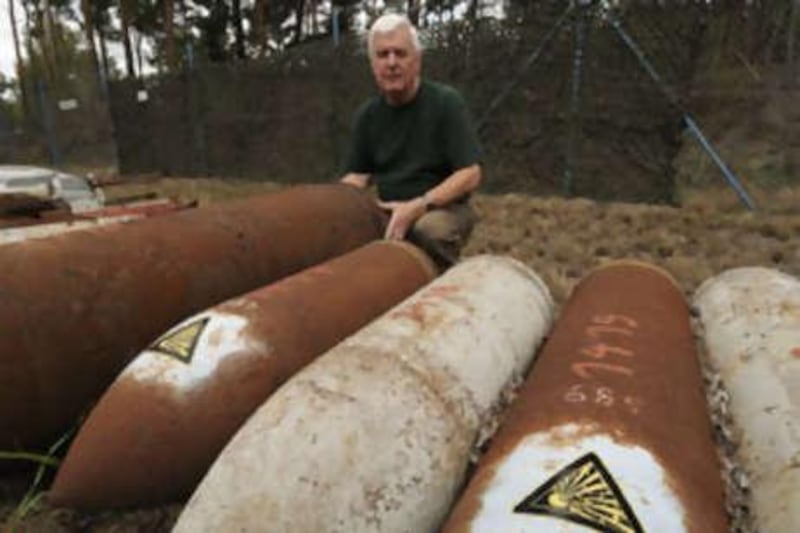BERLIN // Hans-Jürgen Weise has spent almost four decades clearing Second World War munitions from one of the most bomb-contaminated regions in Europe, the German state of Brandenburg surrounding Berlin, and says it will take at least another 20 years before the job is finished.
Mr Weise, 65, who retires this month after a career spent defusing 394 large unexploded bombs and countless smaller ones, said the work was getting increasingly dangerous because bombs were becoming unstable after more than 60 years in the ground. In Brandenburg alone, an average of 631 tonnes of old munitions from the two world wars and from Soviet army exercises in East German times are found every year by construction workers, bomb location squads or children playing.
In the whole of Germany, more than 2,000 tonnes of US and British aerial bombs as well as all kinds of munitions ranging from German hand grenades and tank mines to Russian artillery shells are recovered each year. Delay-action bombs with chemical detonators, of which many were dropped on the Brandenburg town of Oranienburg north of Berlin, are especially treacherous because acetone solvent vapours in the fuses have been wearing through the mechanism over the decades, effectively putting the bombs on a hair trigger, Mr Weise said.
"In the last few years we've found that the detonators we take out of such bombs are increasingly brittle," Mr Weise, who makes the bombs safe by removing the detonators from the explosive, said in an interview. "We've had three extracted detonators go off with a pish sound while they were being transported away, all it took was a bit of vibration. "One day such bombs will be so sensitive that no one will be able to handle them and we'll have to blow them up where we find them because it's simply too dangerous. We may have to stop defusing them as soon as next year. Who wants to gamble with his life? You can always rebuild a house."
Nazi Germany, which was first to launch air raids in the Second World War with devastating attacks on Warsaw and London, was punished with five years of bombing during which the Allies dropped 1.9 million tonnes of bombs in a bid to destroy its industry and crush public morale. The raids killed 500,000 people. Estimates for the percentage of unexploded bombs range from five per cent to 15 per cent - or between 95,000 and 285,000 tonnes. Authorities did not have the time or the means to locate and dispose of a large part of that as Germany hastily rebuilt its cities after the war. As a result, a deadly legacy has lain dormant beneath its streets ever since.
Barely a week goes by without city streets or motorways being blocked off or whole districts evacuated due to an unexploded bomb being discovered during construction work in Brandenburg, in the western Ruhr industrial region or such big cities as Berlin and Hamburg. That is when people such as Mr Weise are called. His final mission was last month in the city centre of Potsdam, which came to a standstill after workers found a 250-kilogram British Second World War bomb at a construction site.
Some 3,000 people were moved from the area and the train station was closed as Mr Weise knelt in the pit gingerly unscrewing the bomb's detonator with a wrench. After he had finished he decided that it would be the last of his career. "When you're on your own in that pit with the bomb in the middle of a city, it's strange how everything suddenly goes totally quiet," Mr Weise said. "Sometimes even the birds stop singing. That's always the point when you feel edgy.
"After the Potsdam bomb last month, I thought, you've been lucky so many times, that's the last one today, now you'll stop." Mr Weise, a fit man with a full head of white hair and a ready laugh, trained as an electrician before starting to work in bomb clearance in 1970, initially helping to locate and transport munitions. He got his qualification to defuse bombs in 1983 and is one of Germany's most experienced bomb disposers.
He has started taking down photos from the wall of his office in the town of Wünsdorf but several remain, showing him and his team smiling with relief alongside defused bombs hanging from hooks or lying on the ground like tamed iron beasts. "I've never had a situation where I gave up, I'm the type of person who always has to finish what they start," Mr Weise said. He said that 47 of his trophies had been the most difficult kind - delay action bombs of which the United States dropped thousands on Oranienburg, a prime target because it had a suspected atomic bomb research site, the Heinkel aircraft factory and a pharmaceutical plant.
They were designed to explode between two and 146 hours after hitting the ground, to disrupt clearing up work and cause chaos. Many of those bombs failed to explode because Oranienburg has soft soil with a hard layer of gravel underneath. That meant bombs would penetrate the earth, bounce off the gravel and come to rest underground with their tips pointing back upwards. In that position, gravity would stop the chemical detonators from working. They contain a vial of acetone, which is meant to burst on impact, trickle down and dissolve a celluloid disk that keeps back the cocked firing pin. But when the bomb is pointed upwards, the acetone seeps away from the celluloid, leaving only the vapours to gradually wear the disk down.
"That explains the large number of unexploded bombs in Oranienburg," said Mr Weise. The search for bombs intensified across Germany in the early 1990s after Britain and the United States handed over air reconnaissance photos taken immediately after the bombing raids. Holes in the ground amid the craters showed the likely locations of unexploded bombs, sometimes to an accuracy of less than two metres.
Bomb disposal teams searched in high priority locations, such as schools, hospital, residential areas and busy streets. In Brandenburg alone, Mr Weise and his team of about 70 colleagues disposed of 10,733 tonnes of munitions between 1991 and 2007 at a cost of ?259 million (Dh1.37 billion), a regional government spokesman said. Apart from aerial bombs, Mr Weise's team removes grenades, mines, artillery shells and guns of all types. Brandenburg is so contaminated because it was here that whole German divisions were annihilated in 1945 in last stands against the Soviet armies advancing on Berlin.
Munitions that can be transported safely are taken to a detonation ground and exploded. Brandenburg has cleared 12,541 hectares of munitions-infested land, but a further 391,000 hectares, or 1,500 square miles, of contaminated area remain. The proactive searching has slowed down due to a shortage of money, Mr Weise said. Most bombs these days are found by chance. "If one were to search systematically and intensively it wouldn't take that long to locate all the bombs but the money isn't there.
"Politicians have the view that if it's been lying there for that long, leave it, it won't hurt anyone, but they start paying attention when something happens." Several people have been injured in spontaneous bomb explosions in Oranienburg over the years and observers have warned that with the passage of time such detonations are becoming more likely. While the detonators are decaying underground, the explosive in the bombs is not.
In 2006, a worker was killed when his bulldozer struck a bomb in southern Germany. Witnesses said the explosion tossed the bulldozer through the air like a toy. Mr Weise said British bombs with conventional mechanical detonators were relatively easy to defuse with a wrench because the detonators were made of brass and did not rust. Still, however routine the defusing has become for him, he never lost respect for any type of munitions.
"I know what can happen and I've seen it. I saw two men killed on the detonation ground in an accident while they were sorting munitions. That stays at the back of your mind and keeps you careful." Three bomb disposal workers have died handling munitions at the Brandenburg detonation ground since 1950. But no bomb defusers have been killed. dcrossland@thenational.ae






